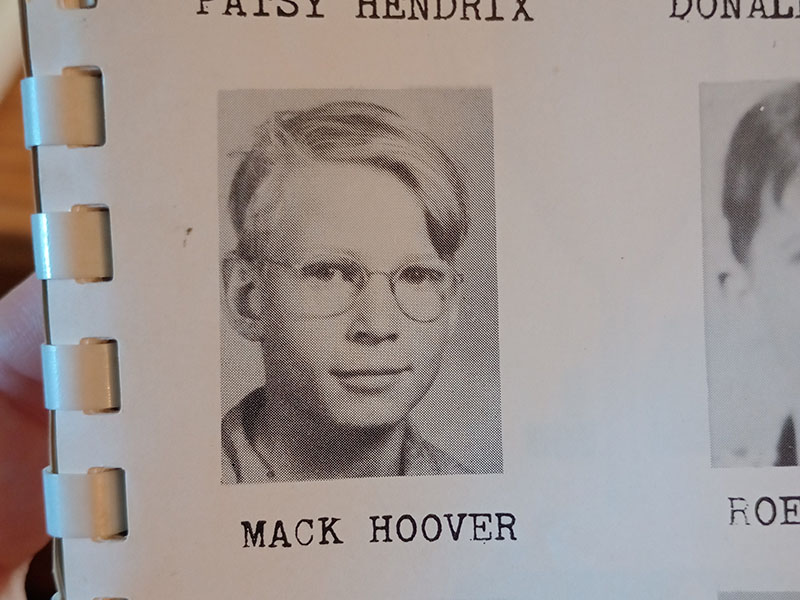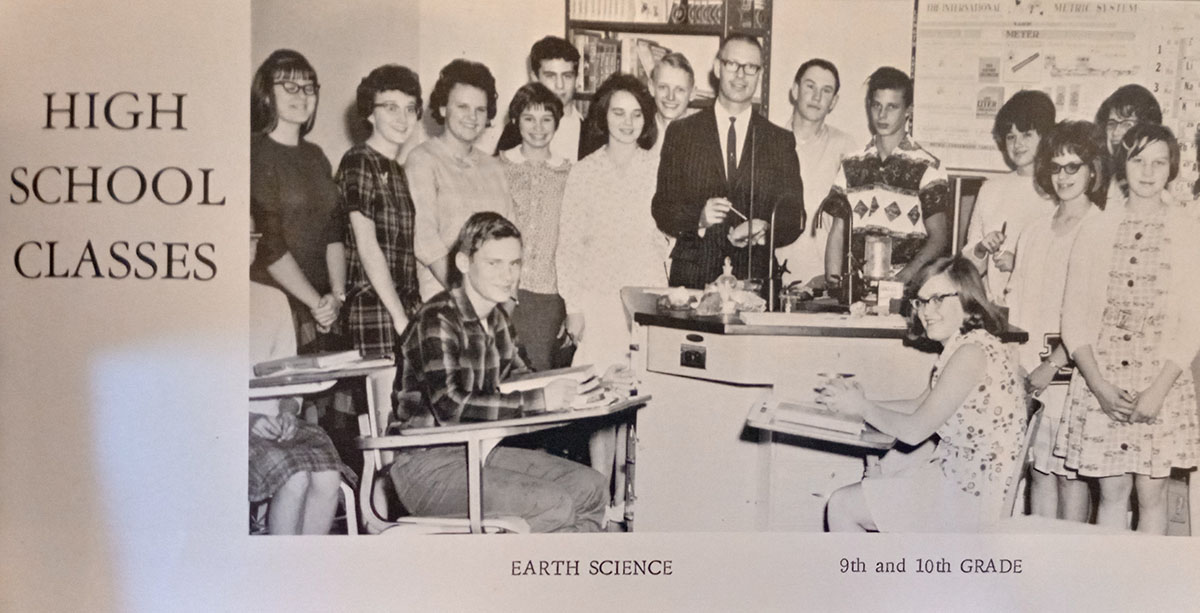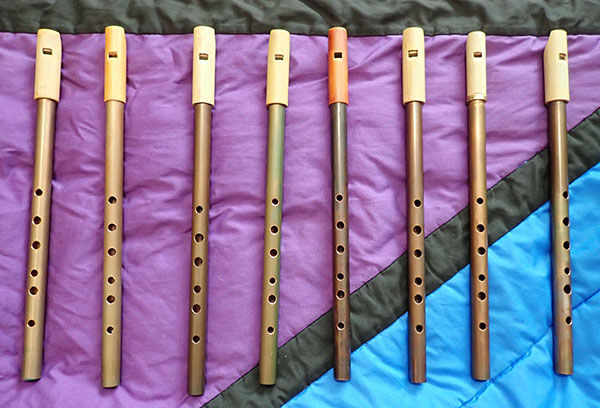
 |
|||||
|
MackBeth whistles has its roots in Hoover Whistles. Hoover Whistles started in the late 1990s with Mack Hoover of Grand Junction, Colorado. This page details Mack's early life, the development of Hoover Whistles, the friendship between Mack and Elizabeth, and the eventual development of MackBeth Whistles as the successor to Hoover Whistles. Mack HooverMack Monte Hoover was born in 1935 in the Colorado Rocky Mountains, at an elevation of over 9,000 feet. He had five sisters and he was the fifth of six children.  Growing up, Mack demonstrated an interest in both music and tinkering. He made his first banjo at 14 years old and his first mandolin at 17. In his words he has "always played instruments", starting with using pencils thumped against a school desk to make different tones. His first tools were a hand drill and a stationary jigsaw, and he would work with his friend Dennis to make various things - spinning tops, spitwad guns, and even dimmable lighting for drama club and a disco ball for dances - throughout his school years. Dennis later went on to become an electrician. Mack graduated from high school in 1953 with a graduating class of only eighteen students, and attended Colorado Mesa City College for pre-engineering, later entering a program called Industrial Arts. He worked during school at a variety of jobs including stoking furnaces, sweeping floors, offloading ice blocks, and even as a bellhop. Mack loved engineering drawing - called descriptive geometry - though he wasn't as fond of the mathematics classes. He gained a year of student teaching experience in the Grand Junction high school shop class while in college. After graduating in 1956 he enlisted in the United States Navy and became a patternmaker, staying with the military for four years. He chose being a Navy patternmaker due to the positive influence of an uncle in Phoenix who had had the same career. Mack described his time in the military as some of the best years of his life. He learned an enormous amount about patternmaking and other practical, industrial work. After leaving the military in 1960 Mack attended Gordon College in Massachusetts for an education program, but ended up leaving to work for a cabinet maker that reproduced early American woodworking styles. While in New England Mack met Joan Noyes of Haverhill, Massachusetts, and after courting they married in February 1963. They moved to Colorado, though they returned to Massachusetts for regular visits to family. Mack found employment in junior high and high schools as a shop teacher and a science teacher, while Joan worked as a licensed nurse. They built a life together in Colorado and raised three children over the years.  WhistlemakingMack's interest in whistles began when he would find spent cartridges laying around the ranch where he lived as a child. He would blow across them to make a sound. He learned to make a willow whistle around the age of ten, and played with making slide whistles from Payon crayons at school and from the spitwad tubes he would make with Dennis - blowing across the open tops of the tubes like a bottle, and changing the pitch by changing the depth of the air within the tube. He once borrowed a metal crutch and learned that he could blow across its holes like a flute - but had to reassemble it and return it to its owner when she complained. Mack's entry into woodwind instrument work started with a silver flute that he bought from a local music store. Someone has traded it in, but it was unplayable and in need of repair. Mack took it apart and fixed it. He had fallen in love with the silver flute when he heard one played in a church service, and while he never learned to play it himself, it did set him on the path toward whistlemaking. He used the willow flute techniques from his childhood as a model, and began experimenting with using straight tubing and arrow shafts to make quiet fippleless whistles. He began watching for whistles and recorders at garage sales. His first work with a traditional fipple whistle was to fix the squawkiness of a commercial Generation whistle. He took the whistle to a family reunion but somehow it didn't come home with him so he bought another. He had to fix that one as well. He began giving some of his early whistles away to musicians he would meet. Hoover WhistlesMack sold a lot of arrow-shaft whistles at a local store that he called 'the guru shop' - but they were just gimmicks at the time, not serious instruments. The first serious musician who asked for and received an arrow whistle through the mail sent it back saying "this is unplayable". A lot of people liked them, though. He was still selling them as he created the narrow bore brass whistle that is most associated with his name. Mack started selling whistles on eBay in the late 1990s; the first one was a silver one sold to someone in Minnesota. Mack was surprised that it sold for $72 - he'd been hoping for a few dollars to cover the cost of the silver! To his recollection it was silver with a copper mouthpiece, but likely not signed or numbered. Then Mack tried rolling copper into a cone and putting a silver mouthpiece on it. This whistle was given to someone locally in Colorado. One particular fan of his work started buying many of Mack's whistles via eBay. He started talking about them online and interest in a whistle by Mack Hoover began to grow. After creating and either selling or giving away about fifty whistles, Thom Larson at the Whistle Shop contacted Mack to ask about selling whistles through his online site. 2000-2004: The Chiff and Fipple DaysIn the days before Social Media there were online discussion boards. One of those was called Chiff and Fipple, the home for all things whistle-related on the internet. It was part of a larger website, part of which can still be seen via the Internet Archive project. Now, only the discussion board remains. Do consider browsing the Archived version of C&F as there are some wacky and wonderful whistle-related materials there. Mack and Elizabeth were both active members of Chiff and Fipple: Mack joined around 1999, already a whistlemaker, and Elizabeth joined in 2001 as a new player. Chiff and Fipple (also called C&F) was a wonderful way for people to share information about whistles, and Mack's quiet, sweet whistles rapidly became highly sought after. One C&F member had purchased one of Mack's whistles secondhand for about $200, and insisted that Mack's work was easily worth that much. This and other positive feedback from the community really encouraged Mack to begin regularly producing and selling whistles, branching out into other keys beyond D as people made requests for various types of whistles. Elizabeth was in college in New York for engineering during this period and had the opportunity to visit Mack at his workshop during a cross country trip in 2002. It was amazing to see a whistle being created and Elizabeth seriously entertained the idea of moving to Colorado to formally apprentice in the craft, but circumstances prevented it at the time. In 2004 Elizabeth moved out of the country and Mack continued on as the region's premiere whistlesmith, with customers far and wide. 2005-2021Mack continued to develop new whistle styles. Having experimented a lot with brass, aluminum, and PVC pipe, he tried making some wooden whistles. He was told by others that oak couldn't be used to make whistles, so of course Mack gave it a try. They turned out well and as far as he knows those whistles are still being used today. He made whistles in other woods as well, but stopped producing them around 2011. There were simply too many problems emerging when a completed wooden whistle went from his shop in dry Colorado to more humid environments. Customers in arid climates loved them, though. The oak whistles handled the moisture changes easily, as the ones that were sent to New York City seemed to perform particularly well. In 2009 Elizabeth moved back to the United States and settled in Oregon. On a road trip in 2010 Elizabeth got to visit Mack once again and see how his work had developed in the intervening years. Elizabeth was in the process of setting up a woodworking shop in Oregon and Mack gifted Elizabeth with a lathe that he no longer needed. It was Elizabeth's first tool in the developing Oregon workshop. By 2011 Mack had started making telescoping whistles in brass. The original models included a pocket clip to keep the whistle securely in one's shirt pocket, but a few of the clips broke and Mack eventually no longer added the clip. Telescoping whistles proved to be immensely popular, and a Youtuber's positive review in 2020 resulted in an almost overwhelming number of order requests. 2022-2023: Passing the TorchElizabeth spent about ten years slowly building a woodworking hobby workshop in Oregon. One spring day in 2022 Elizabeth realised that there was nothing preventing an extended visit to Colorado to finally accept the whistlesmith training offer that had been declined in 2004. Elizabeth and Mack discussed the possibility and Elizabeth travelled to Colorado that summer to learn as much as possible. Mack himself came up with the name "MackBeth Whistles" for his successor. Upon returning to Oregon, Elizabeth set about getting the supplies and materials required to begin building whistles at home. This took longer than expected thanks to a full time job and parenting responsibilities, but by the end of 2023 Elizabeth had begun producing some satisfactory whistles. In 2023 Mack also decided that it was time to retire, and worked with Elizabeth to transfer the Hoover Whistles website to Elizabeth's control so he would no longer need to maintain it. 2024: MackBeth WhistlesIt takes some experience to be able to know what questions remain and what problems need solving. In summer 2024 Elizabeth returned to Colorado once again, to work more with Mack and fine tune some of the building processes and procedures. Mack still makes some whistles, but no longer sells any. He made a set of eight copper C whistles during Elizabeth's visit and sent them home with Elizabeth, along with instructions on who those final instruments should be gifted to. Elizabeth returned to Oregon in July, ready to continue the tradition of handmaking sweet-sounding Irish pennywhistles in the Western United States under the name of MackBeth Whistles.  Many Hoover whistles are out there in the wild; most of them are numbered, and with these Renassance whistles the numbering has passed 3,400. Sometimes they turn up on eBay or at musician secondhand sale sites. If you find one, treasure it! If you have a Hoover and want to send in a photo, description, and any memories about obtaining it and/or working with Mack, we can add a section on the website for this type of history. If you no longer want your Hoover whistle Elizabeth will probably offer to buy it from you. |